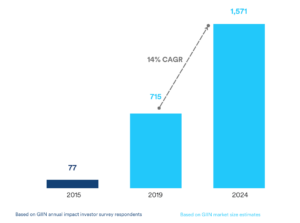
5 Steps™ to Create a Positive Impact

Introduction
As a leading global impact investment manager, BlueOrchard wants to share its expertise from over two decades of experience and contribute to the further growth of impact investing and the conscious use of capital.
In five steps, this guide provides investors with the basic understanding and knowledge required to find the most suitable impact investment product in order to achieve and measure the impact they aim for.
We hope you find a practical use for our impact investing guide. Get started!
What is impact investing?
The term ‘impact investing’ describes an approach to investing that enables investors to seek a social and/or environmental impact alongside a positive financial return. Whilst the popularity of impact investment has increased vastly in recent years, the concept is not new. What started as primarily the purview of development finance institutions (DFIs), has emerged in the private sector through the rise of the ‘microfinance’ sector and the effort to use private capital to expand financial inclusion in the world’s emerging markets. Since then, the concept has expanded into a range of asset classes including debt, equity, and structured products and seeks to bring a private market approach to solving critical challenges of global development.
Impact investing challenges the traditionally held belief that financial returns and social and/or environmental impact are mutually exclusive. The core principle behind an impact investment strategy is the idea that investments can simultaneously achieve financial return for capital providers and contribute value in communities where those investments are placed. These two critical elements work in a complimentary fashion, reinforcing each other and serving a broader purpose.
Often, the terms ‘impact investing’, ‘socially responsible investing’ (SRI), and ‘ESG investing’ (environmental, social, and governance) are used synonymously, although these approaches differ from each other at a decisive point: In simple terms, SRI and ESG investing are about the application of exclusion and inclusion criteria and focus on the conduct and governance of the company in which funds are being invested.
Impact investing, on the other hand, is the conscious and intentional decision to invest in order to achieve a previously defined, measurable social and/or environmental objective alongside a financial return. In the impact investment sector, this concept is commonly known as the ‘double/triple bottom line’ approach.
Differentiation of impact investing
Source: BlueOrchard.
Impact investing accomplishes
double/triple bottom line
Why impact investing?
The world at large faces a massive array of challenges to economic and social development. Impact investing is an innovative way of combining the power of global capital markets with the drive to reduce poverty, inequality, and climate change, among other pressing concerns.
In this context, the United Nation’s Sustainable Development Goals (UN SDGs) have become a ‘north star’ of sorts for impact investment stakeholders around the world. The SDGs call for global action amongst governments, businesses, and civil society to end poverty and create a life of dignity and opportunity for all.
In developing countries alone, the investment gap across all SDG sectors has increased from $2.5 trillion in 2015 to more than $4 trillion per year. It is abundantly clear that government financing cannot, by itself, fix these problems. Private capital is not only relevant, it is essential to achieving the SDG objectives.
Within the realm of private capital, philanthropic sources can only fill a part of the overall finance required to meet these SDGs. The private sector, therefore, has a key role in mobilising and increasing investments.
In an age of 24 hour news and connectivity, there has never been greater awareness of the challenges and concerns facing the societies and economies of the world.
UN Sustainable Development Goals (SDGs)
Source: UN.
Performance comparison of MSCI Europe SRI and MSCI Europe
Source: Bloomberg, MSCI, 2020.
This vastly increased awareness is a major factor in the growth of impact investing as a concept. Today, a new generation of investors which includes a historically high proportion of women, millennials, and ethnic/cultural diversity seeks not only financial returns, but also the chance to use their resources to make a positive contribution and remodel industries in a more sustainable, accountable, and responsible context. People are rejecting the idea that investments cannot be made in accordance with personal and social value systems and the global markets are taking notice.
Investors need to balance risk and impact with financial return. Evidence developed over the past 20 years consistently shows that impact investing can generate positive return alongside tangible social and environmental benefits. Correlation between sustainable and impact investing and financial performance has been tested, demonstrating affirmative synergies across risk, return, and impact metrics. Looking at equity markets, for example, over the past 10 years, the MSCI Europe SRI has substantially outperformed its traditional assets sister MSCI Europe.
Historically, the focus of impact investments has been on areas that are traditionally not accessible via public markets. Low volatility and low correlation between private markets and more traditional asset classes made impact investing
an attractive diversification option.
At the same time, governments are increasingly offering incentives and favourable regulatory environments, which aim at scaling up impactful investments. One of these is, for example, the European Union’s taxonomy regulation for sustainable investments (EU taxonomy), which is meant as an enabler for the implementation of the European Green Deal, a set of European policy initiatives to make Europe climate neutral by 2050 and reduce greenhouse gas (GHG) emissions. Another example of increased regulatory activities is the EU’s Sustainable Finance Disclosure Regulation (SFDR), which aims to provide more transparency and standardisation in order to prevent greenwashing and ensuring comparability. Amongst other things, it classifies products along with their investment approach, from sustainable themed investments over ESG integration to impact investing. Products promoted as ESG or impact investing are then required to be classified under a specific SFDR article.
It is therefore no surprise that the size of the impact investing industry has quadrupled in the past years. Both retail and institutional investors, such as pension funds, insurance companies, banks, family offices, foundations, and religious institutions, are significantly increasing their allocations to impact investments. This growth is also a result of the increased availability of attractive impact investment opportunities across all asset classes. Today, the industry has reached a size that enables the absorption of large investments, supporting the investment appetite and commitment of institutional investors in the private sector.
Growth of the global impact investing industry AuM in USD billion
Source: Global Impact Investing Network (GIIN), 2024.

Read enough? Then take our 5 Steps quiz to get your impact profile.